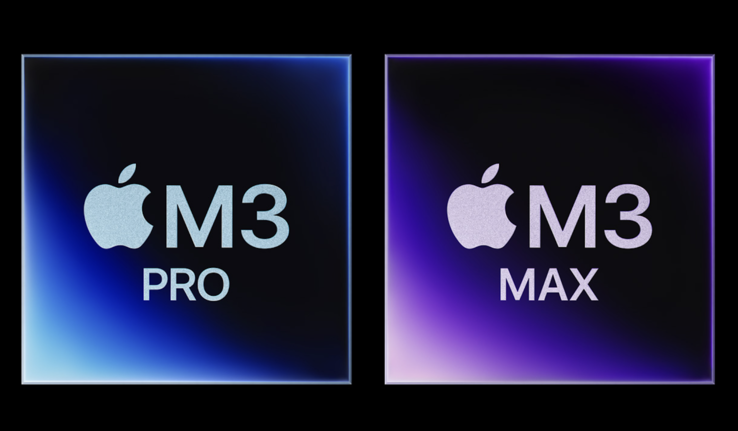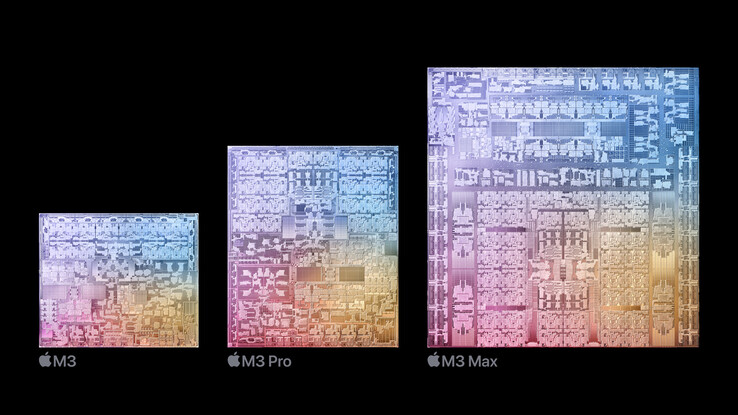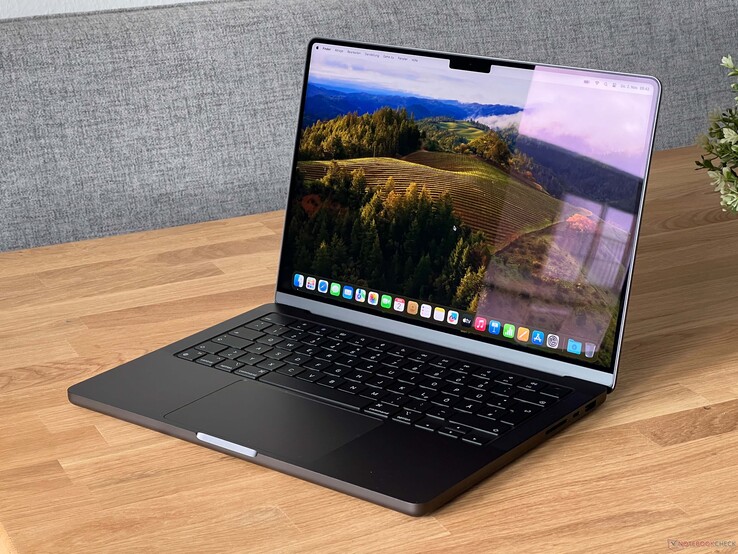Apple M3 Pro & M3 Max analysis - Apple has significantly upgraded its Max CPU
Apple has recently unveiled its new M3 SoCs (M3, M3 Pro & M3 Max) which are produced using a modern 3-nm process. We already took a detailed look at the new base M3 SoC's performance and efficiency, so now it's the faster M3 Pro and M3 Max chips' turn. Aside from them now being made using a 3-nm process, they also feature a wide range of new changes, in particular regarding how their performance and efficiency clusters are built. Furthermore, we will be comparing their performance and efficiency with those of AMD, Intel and Nvidia CPUs/GPUs. Subsequently, we will be comparing them to the new Snapdragon X Elite, only recently presented by Qualcomm.
Apple M3 Pro & M3 Max overview
The change to the M3 generation has brought with it lots of differences when it comes to the Pro and Max models. The regular M3's core configuration hasn't been changed (still one performance cluster and one efficiency cluster with four cores each), whereas the new Pro/Max chips' clusters consist of 6 cores each. The M3 Pro features a performance cluster with 5 or 6 active cores, as well as an efficiency cluster with 6 cores. This means you can get the M3 Pro with 11 or 12 CPU cores. The new M3 Max, on the other hand, has had its CPU performance massively increased by Apple, as it now uses two performance clusters (with 5 or 6 active cores each) in combination with a slimmed-down efficiency cluster (4 cores) — meaning this is a CPU with either 14 or 16 cores in total. While the new M3 Pro focuses mainly on efficiency, the M3 Max is definitely targeted more toward maximum CPU performance.
The CPU cores themselves are almost identical on all of the M3 models. The performance cores can achieve a maximum of 4.056 Ghz or ~3.6 GHz when all cores are placed under load in the M3, and up to 2.748 GHz in the M3 Pro — however, the M3 Max can only achieve up to 2.567 GHz. Thanks to their new 3-nm finish (presumably N3B process at TMSC), Apple has managed to clearly improve their clock rates without having to make all too many compromises when it comes to power consumption.
Together with their different RAM capacities (18 or 36 GB in the M3 Pro; 36, 48, 96 or 128 GB in the M3 Max) as well as their different GPU configurations, the chips differ significantly from each other in terms of structure and a direct comparison shows that the new M3 Max is a significantly larger chip than the M3 Pro.
Apple has revised the GPU's entire architecture, now only using dynamic caching, whereby the cache and memory are allocated dynamically based on the actual requirements of applications. In addition, the M3 Pro/M3 Max's GPUs now support hardware-based ray tracing, mesh shading and AV1 decoding. The M3 Pro (14 or 18 GPU cores) can control two external screens in addition to the integrated display, while the M3 Max (30 or 40 GPU cores) can power four.
Test procedure
In order to make a meaningful comparison between the different processors and graphics cards, we will be taking a look at their power consumption in addition to their pure performance in synthetic benchmarks, from which we will then determine their efficiency. Our consumption measurements are always carried out on an external display so that we can eliminate the different internal displays as influencing factors. Nevertheless, we will be measuring the system's overall consumption, not just relying on the displayed CPU and GPU values. This is, of course, why the different chip sizes, including more RAM etc., also play a role.
Single-core performance
The single-core performance is practically identical in all of the new M3 SoCs and in this aspect, Apple was able to increase their performance by a whopping 20 % compared to the old M2 generation. Compared to the M1 generation, their performance is even 30 % higher. The CPU itself has a power consumption of around 5.5 watts (according to Power Metrics), although we noticed some slight differences between the individual CPUs.
These slight fluctuations definitely have a major impact on efficiency, as their overall consumption is so low. The small M3 Pro with 11 CPU cores in the MacBook Pro 14 performed particularly well, even placing ahead of the Apple M3 in our measurement. The M3 Pro with 12 CPU cores performed slightly worse but it still came ahead of the old M2 Pro.
| Power Consumption / Cinebench R23 Single Power Efficiency - external Monitor | |
| Apple M3 Pro 11-Core | |
| Apple M3 | |
| Apple M2 | |
| Apple M1 | |
| Apple M2 | |
| Apple M3 Pro 12-Core | |
| Apple M2 Pro | |
| Apple M3 Max 16-Core | |
| Apple M2 Pro 10-Core | |
| Apple M3 Max 16-Core | |
| Apple M1 Pro | |
| Power Consumption / Cinebench R23 Single (external Monitor) | |
| Apple M3 Max 16-Core | |
| Apple M3 Max 16-Core | |
| Apple M1 Pro | |
| Apple M2 Pro 10-Core | |
| Apple M3 Pro 12-Core | |
| Apple M2 Pro | |
| Apple M3 | |
| Apple M2 | |
| Apple M3 Pro 11-Core | |
| Apple M1 | |
| Apple M2 | |
* ... smaller is better
Multi-core performance
We noted significantly greater differences in their multi-core performance. Firstly, the M3 Pro offers slightly more performance than the old M2 Pro despite it having fewer performance cores, but Apple has also been able to reduce its power consumption. The small M3 Pro with 11 CPU cores consumes around 24 watts (M2 Pro with 10 cores: around 27 watts); the M3 Pro with 12 CPU cores consumes about 27 watts (M2 Pro with 12 cores: around 34 watts). More performance with lower consumption naturally means significantly better efficiency, and the new M3 Pro is clearly the leader in this respect.
We have so far only been able to test the top-of-the-range version of the M3 Max with 16 CPU cores and its performance advantage over the M3 Pro and the old M2 Max is a whopping 54-56 %, meaning Apple has finally gotten rid of a major point of criticism that the old models had. Although its power consumption has also increased significantly (M3 Max up to 56 watts; M2 Max up to 36 watts), its efficiency is still slightly better than the M2 Pro/M2 Max — but the M3 Max didn't come close to the M3 Pro's efficiency in our multi-core tests.
| Power Consumption / Cinebench R23 Multi Power Efficiency - external Monitor | |
| Apple M3 Pro 11-Core | |
| Apple M3 Pro 12-Core | |
| Apple M2 | |
| Apple M2 | |
| Apple M1 | |
| Apple M3 Max 16-Core | |
| Apple M3 Max 16-Core | |
| Apple M1 Pro | |
| Apple M2 Pro | |
| Apple M2 Pro 10-Core | |
| Apple M2 Max | |
| Power Consumption / Cinebench R23 Multi (external Monitor) | |
| Apple M3 Max 16-Core | |
| Apple M3 Max 16-Core | |
| Apple M2 Max | |
| Apple M2 Pro | |
| Apple M2 Pro 10-Core | |
| Apple M1 Pro | |
| Apple M3 Pro 12-Core | |
| Apple M3 Pro 11-Core | |
| Apple M2 | |
| Apple M2 | |
| Apple M1 | |
* ... smaller is better
Apple M3 Pro/Max vs. AMD and Intel
Now to compare the new Apple M3 generation with other current mobile processors from AMD and Intel. In the case of AMD, both its U-series chips and its HS processors prove to be interesting competitors, while Intel's main competitors are the Raptor Lake P and Raptor Lake H processors.
Let's start with single-core performance. Here, you can clearly see what a big step Apple has taken with its M3 generation. Despite its low power consumption, its new performance core can easily keep up with the performance cores of the current Raptor Lake CPUs from Intel, which require significantly more power. Only the i9 CPUs from Intel (H or HX) offer slightly more performance thanks to their high turbo clocks, but they fall significantly behind in terms of efficiency. However, all other CPUs (Ryzen 9 7945HX, Core i7-13700HX etc.) are kept in check by the Apple M3 chips.
| Power Consumption - Cinebench R23 Single Power Efficiency - external Monitor | |
| Apple M3 Pro 12-Core | |
| Apple M3 Max 16-Core | |
| AMD Ryzen 7 7840U | |
| AMD Ryzen 9 PRO 7940HS | |
| Intel Core i7-13700H | |
| AMD Ryzen 7 7840S | |
| Intel Core i7-1360P | |
| AMD Ryzen 9 7945HX | |
| Intel Core i9-13980HX | |
In our multi-core tests, the tide changes a little, as the HX CPUs from AMD (Ryzen 9) and Intel (Core i9-HX) offer more performance than the M3 Max can, especially during the Cinebench R23 test. However, you shouldn't forget that they consume significantly more power (well over 100 watts).
The M3 Pro, on the other hand, is on par with slower variants of the 45-watt CPUs from AMD and Intel, such as the Ryzen 9 7940HS or the Core i7-13700H. However, these slower variants also require more power, which can be seen from their efficiency. However, AMD is still within striking distance, especially with its Ryzen 7 7840U — only beaten by the new M3 Pro with 11 CPU cores in terms of multi-core efficiency. Intel, on the other hand, falls significantly behind and can hardly compete in this aspect.
| Power Consumption / Cinebench R23 Multi Power Efficiency - external Monitor | |
| Apple M3 Pro 11-Core | |
| AMD Ryzen 7 7840U | |
| Apple M3 Pro 12-Core | |
| Apple M3 Max 16-Core | |
| AMD Ryzen 9 PRO 7940HS | |
| AMD Ryzen 7 7840S | |
| Intel Core i7-1355U | |
| Intel Core i7-1365U | |
| AMD Ryzen 9 7945HX | |
| Intel Core i7-13700H | |
| Intel Core i7-1360P | |
| Intel Core i7-13700H | |
| Intel Core i7-13700H | |
| Intel Core i9-13980HX | |
| Qualcomm Snapdragon 8cx Gen 3 | |
GPU performance & efficiency
We primarily use the cross-platform 3DMark-Test Wildlife Extreme Unlimited to test graphics performance, as this gives us a good direct comparison to Windows computers. The new M3 Pro gives you a relatively small advantage of around 10 % compared to the predecessor models and the large M3 Pro GPU can keep up with the RTX 4050 Laptop or a slower variant of the RTX 4060 Laptop. In our OpenCL test from Geekbench, the GeForce CPUs did much better.
During the 3DMark test, the new M3 Max GPU with 40 cores (maximum 60 watts) came 25 % ahead of the old M2 Max GPU with 38 cores (maximum 64 watts) and only 9 % behind the dedicated GeForce RTX 4090 Laptop with a TGP of 125 watts. However, the M3 Max GPU's OpenCL performance was again significantly worse and it even fell behind the GeForce RTX 4060 laptop (80-watt TGP).
| Geekbench 5.5 / Metal Score | |
| Apple M3 Max 40-Core GPU | |
| Apple M2 Max 38-Core GPU | |
| Apple M3 Pro 18-Core GPU | |
| Apple M2 Pro 19-Core GPU | |
| Apple M2 Pro 16-Core GPU | |
| Apple M3 Pro 14-Core GPU | |
| Apple M1 Pro 16-Core GPU | |
| GFXBench / Aztec Ruins High Tier Offscreen | |
| Apple M3 Max 40-Core GPU | |
| Apple M2 Max 38-Core GPU | |
| Apple M3 Pro 18-Core GPU | |
| Apple M2 Pro 19-Core GPU | |
| Apple M2 Pro 16-Core GPU | |
| Apple M3 Pro 14-Core GPU | |
| Apple M1 Pro 16-Core GPU | |
When looking at efficiency, we have to reach for the Windows game The Witcher 3, as this gives us the most comparative values and the CPU load is quite low. Of course, this is not an optimal starting situation for the MacBooks and the resulting values are not fully comparable with Windows laptops, as only the emulated version runs on the Macs via CrossOver. This naturally also costs some performance. With last year's M2 Pro models, we also carried out the test on MacBooks for the first time and they were able to take the lead in the comparison field.
The new M3 models (both M3 Pro versions and M3 Max) came out on top despite these poor conditions, although the RTX 4090 Laptop (125 watts) in the Asus ROG Zephyrus G14 wasn't much worse and it, of course, offers significantly more gaming performance overall.
Apple M3 Pro/Max vs. Qualcomm Snapdragon X Elite
Prior to the new M3 MacBooks being announced, Qualcomm presented its new Snapdragon X Elite SoC and also published some benchmark results that are able to provide us with a good comparison. Two systems were shown, one with a reference design of 23 watts and one with 80 watts.
In terms of CPU performance, the Snapdragon performs well overall. Although the M3 models were faster in the single-core tests, their lead wasn't all too large. In the Cinebench 2024 multi-core test, however, the reference system with 23 watts came ahead of the M3 and the M3 Pro with 11 CPU cores and the gap to the M3 Pro with 12 CPU cores was only 10 %. The 80-watt system did better than the M3 Pro models, but it couldn't keep up with the new M3 Max with 16 CPU cores when it came to performance.
| Geekbench 6.5 / Multi-Core | |
| Apple MacBook Pro 14 2023 M3 Max | |
| Apple MacBook Pro 16 2023 M3 Pro | |
| SD X Elite Reference 80W | |
| Apple MacBook Pro 14 2023 M3 Pro | |
| SD X Elite Reference 23W | |
| Apple MacBook Pro 14 2023 M3 | |
The GPU performance looks worse, as even the more powerful 80-watt reference system of the Snapdragon X Elite can only beat the 10-core GPU of the normal Apple M3, but all other GPUs of the M3 Pro/Max models are more powerful.
| GFXBench - 1920x1080 Aztec Ruins Normal Tier Offscreen | |
| Apple MacBook Pro 14 2023 M3 Max | |
| Apple MacBook Pro 16 2023 M3 Pro | |
| Apple MacBook Pro 14 2023 M3 Pro | |
| SD X Elite Reference 80W | |
| Apple MacBook Pro 14 2023 M3 | |
| SD X Elite Reference 23W | |
Verdict - The M3 Max is now the undisputed Apple flagship
We already saw in our analysis of the base M3 SoC that Apple was able to increase its clock rates thanks to a new 3 nm production — without increasing the power consumption. This, of course, applies to the new variants of the M3 Pro and M3 Max, too. As the actual cores are also identical, there are no significant differences in single-core performance between the M3 variants, as was the case with the previous models. Apple was able to increase this by a massive 20 % compared to the M2 generation. As a result, Apple has overtaken AMD's Zen4 in one fell swoop and the gap to Intel's performance cores has been closed. Only the HX models such as the Core i9-13980HX still have an advantage thanks to their very high turbo clock, but this comes at the expense of power consumption, which is also reflected in their efficiency.
Apple has massively upgraded its new M3 Max, because in addition to its more powerful GPU, it now also features a significantly faster CPU — while the new M3 Pro places a greater focus on efficiency.
When it comes to multi-core performance, there are major differences in the M3 Pro/M3 Max, as Apple has changed their core configuration compared to the M2 generation. In addition, the CPU performance of the old M2 Pro/Max CPUs was identical, which is no longer the case. The new M3 Max has received twice the number of fast performance cores but in turn, it has sacrificed two efficiency cores. In addition to the more powerful GPUs, the M3 Max SoCs now also offer significantly more CPU performance compared to the M3 Pro. In comparison with AMD and Intel, the M3 Max is only beaten by the HX CPUs, which require significantly more power. This makes the MacBook Pro 14 with the M3 Max the fastest 14-inch laptop on the market when it comes to CPU performance, as the HX CPUs are only available from 16 inches upwards. Apple was also able to further increase its GPU performance, but its overall performance is still well behind the fast dedicated graphics cards.
With the M3 Max CPU, Apple has finally managed to close the gap to the fast AMD and Intel processors; only the Core HX models with a power consumption of significantly more than 100 watts offer even more multi-core performance.
When it comes to efficiency, Apple still has an advantage — especially over Intel — and we are curious to see whether the new Meteor Lake processors can change this. However, AMD can come much closer with its Zen4 processors. The Ryzen 7 7840U in particular is very efficient and can come quite close to Apple in the 30/25 watt range. The Apple GPUs now also offer more performance and cope very well with native games (such as Baldur's Gate 3 or No Man's Sky) and their efficiency is still very good — but nevertheless, dedicated graphics cards offer more overall performance and are still the better choice if you want to play a lot of games. However, Apple GPUs still have an advantage when it comes to video editing in particular, as they can access the shared RAM.
All in all, the new M3 generation is a clear step forward for Apple, as both performance and efficiency have been increased thanks to their new 3 nm production process. However, AMD is not far behind and the situation could change with its upcoming Zen5 chips. Intel lags behind, especially in terms of efficiency (and of course the integrated GPU), but this is exactly where the upcoming Meteor Lake generation should come in. The new Qualcomm Snapdragon X Elite seems to be able to keep up well, especially when it comes to CPU performance, but there is no concrete information on its availability yet.







